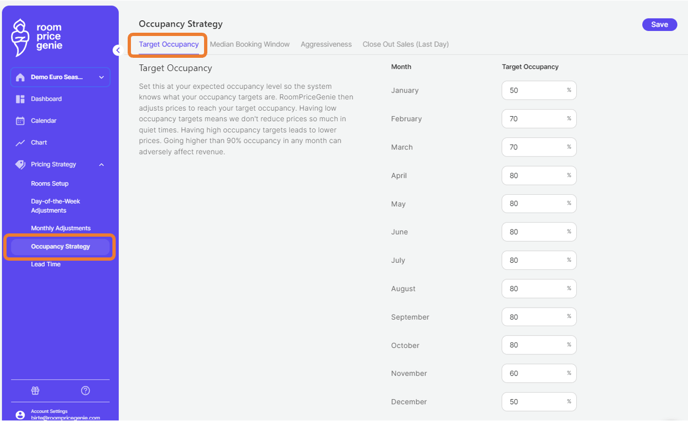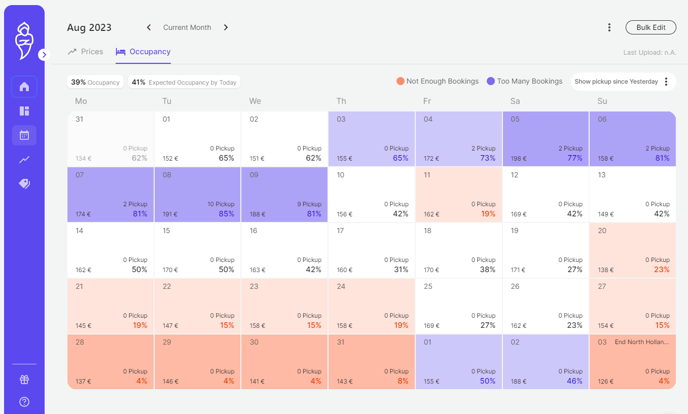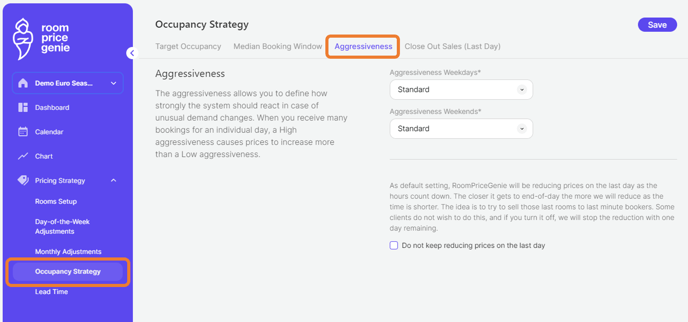Occupancy Strategy
Learn all about the 'Occupancy Strategy' tab in RoomPriceGenie.
| Product Plan |
|---|
| Advanced |
| Professional |
Different hotels have different needs and strategies. In order to allow for this, we have built a lot of flexibility into the RoomPriceGenie algorithm. In RoomPriceGenie, the Occupancy Strategy is composed by the following factors:
- Target Occupancy
- Median Booking Window
- Aggressiveness
- Close-Out Sales (Last Day)
- Shoulder Night Discounts
We’ll explain each of these individually, and we’ll explain how to set it up and how they combine to affect your price recommendations and your Occupancy Calendar.
1. Target Occupancy

- The more realistic expectations, the better price recommendations! For example, if you normally get 40% occupancy in January, set the Target Occupancy in January at 40-50%. There is no harm in aiming a little higher than you usually get if your occupancy is low.
Remember: Even if you have set a lower monthly target occupancy, that does not mean that you will not be able to reach a higher one... You will still be able to do so, but at a higher ADR.
- If your target is too high, the price recommendations will be lower in order to try to reach that target. If your target expectations are unfeasible then you may be sacrificing the average daily rate, without getting the occupancy pick-up you need to make it worthwhile.
Caution: We don’t recommend setting Target Occupancy to 90% or above, because this will usually lower your prices too much.
| Short | Half your bookings come less than 14 days before arrival. | Typical for city hotels. |
| Standard | Half your bookings are made more than 14 but less than 30 days. | This is the default setting. |
| Long | Your average booking is made more than 30 days before arrival. | This may be the case for ski resorts or other destination hotels. |
Actually, it’s a bit more complicated, if we are being precise. We want to know the lead-time median for your market as a whole rather than your hotel. This should be available on booking.com analytics.
Tip: If you need a custom option, please let your customer service executive know.
Target Occupancy & Lead Time Median – How do they work together?
Target Occupancy & Lead Time Median - How will they affect the price recommendations?
- Option 1 - Higher target and longer lead time would both increase the expected occupancy; which would mean lower prices!
- Option 2 - Lower target and a shorter lead time would both decrease the expected occupancy; which would mean higher prices!


-
How exactly does this affect pricing?
The ‘full-month-adjustment’ setting fixes the pricing for a whole month and is determined by whether you are above or below expectations. It is a setting implemented in RoomPriceGenie’s algorithm automatically. The system itself is already set to reflect your Monthly Target Occupancy and Lead-time Median.
The pricing for each day is affected both by the availability on that day (optimising your prices for the rooms you have left) and also by the 'full-month adjustment' which looks at the whole month.
-
What should I do about it?
Because of the ‘full-month-adjustment’, we take care of whether you are above or below target for the month, and you don’t need to worry. If you are getting too full too soon, the prices will automatically rise. If the bookings are not coming in then the whole month of prices will be adjusted lower to compensate.
You need to react only if you don’t agree with it or if things have changed for your business.
-
What if I have a few very busy days in a quiet month?
When we see a very quiet month, the whole month will be adjusted down. If you have a few busy days, e.g., for a concert or a holiday, you may find that these prices are a little low. To deal with this, you can add a positive adjustment to the price on the busy days, using the price pop-up or adjustment calendar.
3. Aggressiveness
So, we know your expected occupancy target [because you can enter monthly target occupancy yourself], your current occupancy [we receive that data from your PMS/Channel Manager], and the lead-time median. What do we do if we’re ahead or behind targets?
We generally recommend leaving this on Standard. For some very small hotels, we would suggest Low or Very Low. Learn more about it here: Aggressiveness.
Variable Costs
When RoomPriceGenie is optimising your revenue, we want to make sure that these costs are taken into account and that you make enough profit on each room sold. Learn more about it here: Variable Costs.
Aggressiveness & Variable Costs – How do they work together?
4. Close out Sales (Last Day)
If you close out sales on the last day(s) after a certain time, please update the same in RoomPriceGenie. Otherwise, we might fetch the wrong availabilities.
 Setting up the correct time for closing out sales for the day.
Setting up the correct time for closing out sales for the day.
Note: Target Occupancy is different from occupancy based prices; Occupancy based prices is the ability of setting the room price according to the occupants (number or people in the room) = per person price: for instance, if 1 person the price is 100, if 2 the price is +50 (150).
5. Shoulder Night Discounts
Automatically adjust prices when nearby dates are fully booked.
Shoulder Night Discounts allow you to automatically reduce your prices on certain dates when availability around them becomes limited. This helps maintain bookings even when guests are restricted in their stay options.
What Are Shoulder Nights?
Shoulder nights are dates that sit next to fully booked nights—either 1 or 2 nights before or after. If those surrounding nights are unavailable, guests have fewer flexible options, and demand may drop for the shoulder night itself.
To counter this potential drop in demand, you can apply an automatic discount. For example:
-
If either 1 night before or after is fully booked, we apply the base discount.
-
If both 1 night before and after are fully booked, the discount is doubled.
-
The same logic applies to 2 nights before and/or after. Discounts are cumulative.
Example
Let’s say you configure a 15% discount:
-
If just one night before a date is fully booked, we apply 15%.
-
If both the night before and after are booked, we apply 30%.
-
You might see a rounded 28% in your adjustment drawer—this is just how multiple discounts are condensed visually.
Important Notes
-
This feature works at the property-wide availability level, not per room type.
-
The adjustments will appear as a single line in your price adjustment drawer for clarity.
-
Currently, this feature is live on about 10% of properties. It will roll out to all properties over the next few days.

